Kuus ransomware – the 241st member of Djvu ransomware family
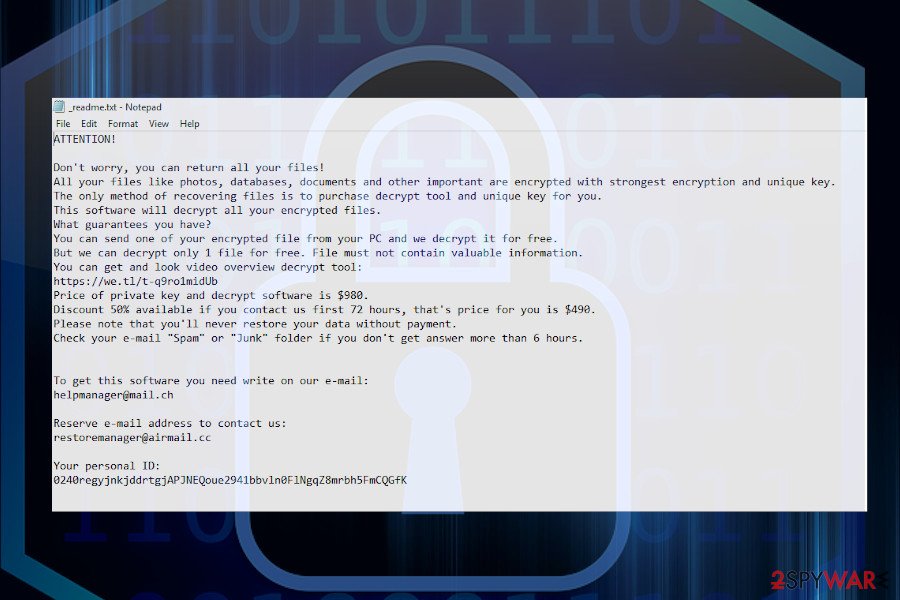

Kuus file-encrypting virus or ransomware that has resurfaced in the second half of July 2020. Detected by the well-known ransomware hunter Michael Gillespie[1], the ransomware has been proved to be the 241st variant of the STOP/Djvu ransomware family. Just like its predecessors, this virus takes advantage of the software cracks, keygens, password unprotected RDPs, and other stealthy infiltration strategies.
If the payload dropper is activated, the ransomware runs a bunch of malicious files, including , f6ff.tmp.exe, c7c6.tmp.exe, and 6AEC.tmp.exe. This group of files is responsible for damaging the system, running the AES-256 encryption algorithm, and taking control over all personal files stored on the infected machine. If successful, the operation ends up in a complete lock of personal data stored on the system. All pictures, documents, archives, etc. get .kuus file marker and cannot be opened any longer. Ransomware managers provide a sole problem solution – paying the ransom, which is $490 if paid within 72 hours or $980 if later.
| Name | Kuus |
| Type | Ransomware/file-encrypting virus |
| Family | STOP/Djvu |
| Version | 241st member of Djvu virus |
| Ransom note | _readme.txt |
| Criminal contacts | [email protected], [email protected] |
| File extension | .kuus file marker |
| Symptoms | Personal files can no longer be accessed. All of them have an unusual file extension attached. Alternatively, the machine runs slower than it used to before, high CPU usage can be noticed |
| Danger level | High. The ransomware can permanently delete personal files, cause money loss, or download other viruses to the system |
| Can files be decrypted? | .kuus file decryptor is not yet available. However, there are several alternatives that can be applied for unlocking some of the encrypted files |
| Removal | Before any attempts to regain access to the personal files, it’s a must to remove the ransomware from the machine. For this purpose, use a trusted anti-virus program |
| Fix virus damage | Ransomware damage to the system is severe. The malware runs a multiplicity of commands via an elevated PowerShell aiming at Registry corruption, disability of system files, startup processes, and more. To fix suchlike damage, try using Reimage Reimage Cleaner Intego repair tool |
.kuus file virus is a ransomware that has been expected as a weekly Djvu ransomware family augmentation. Initially, it’s difficult to forecast which variant will be prevailing, but the latest practice with Maas, Zida, Repl, Usam, and others show that the latest releases of this ransomware family are perspective.
Djvu Ransomware virus remains one of the most active viruses since 2019 taking approximately 56% of the active file-encrypting ransomware market. Although variants released before 2019 August can be successfully decrypted using an official decryptor by Emsisoft, the latest variants cannot be cracked by the same decryptor because they are using online keys. In other words, all the keys provided to the victims are unique and generated in a secure manner, which is why there’s no working decryptor for the new versions like the Kuus ransomware virus.
The installation of the ransomware is spotted by the owner of the infected machine because all files (except system files) are encrypted by .kuus extension. Compromised files lose their typical logos, i.e. instead of PDF file logo victim sees a blank logo. Apart from inaccessible files, the ransomware manifests its presence by creating a _readme.txt note on the desktop and many other non-system files. The note says:
ATTENTION!
Don’t worry, you can return all your files!
All your files like photos, databases, documents and other important are encrypted with strongest encryption and unique key.
The only method of recovering files is to purchase decrypt tool and unique key for you.
This software will decrypt all your encrypted files.
What guarantees you have?
You can send one of your encrypted file from your PC and we decrypt it for free.
But we can decrypt only 1 file for free. File must not contain valuable information.
You can get and look video overview decrypt tool:
https://we.tl/t-7YSRbcuaMa
Price of private key and decrypt software is $980.
Discount 50% available if you contact us first 72 hours, that’s price for you is $490.
Please note that you’ll never restore your data without payment.
Check your e-mail “Spam” or “Junk” folder if you don’t get answer more than 6 hours.To get this software you need write on our e-mail:
[email protected]Reserve e-mail address to contact us:
[email protected]Your personal ID:
The ransomware sample has been uploaded to VirusTotal[2] scanner the day the virus has been released. Based on the results, Kuus removal can be successfully initiated by 47 AV programs out of 72 possible. Typically, the security tool warns the user about the presence of the following infection:
- Win32:CrypterX-gen [Trj] (AVG)
- Trojan.GenericKD.43514787 (BitDefender)
- Trojan.GenericKD.43514787 (B) (Emsisoft)
- W32/Ursnif.DA!tr (Fortinet)
- Trojan.MalPack.GS (Malwarebytes)
- TrojanSpy.Win32.EMOTET.USXVPGI20 (TrendMicro)
- A Variant Of Win32/Kryptik.HEYU (ESET-NOD32)
- Trojan.Win32.Chapak.equk (Kaspersky)
- Trojan:Win32/Glupteba.DSE!MTB (Microsoft), etc.
If the system states showing such and similar alerts, do not ignore them. Kuus ransomware removal should be performed immediately to minimize the system damage. Besides, the elimination is needed to start data decryption. However, since the ransomware may run malicious files to block AV tools, you may need to restart the system into Safe Mode with Networking.
As soon as you remove Kuus ransomware, you can pursue with the .kuus file decryption methods. If you have data backups, we recommend you to remove the virus ASAP and use the copies that you have. That’s the best scenario possible. If, however, you don’t have backups, there are several data recovery options:
- Pay the ransom expecting that criminals will provide a functional decryption key;
- Use third-party data recovery programs, such as Data Recovery Pro;
- Check for Shadow Volume Copies;
- Take advantage of the Previous Version feature.
A full guide on .kuus file recovery is provided at the end of this article. However, before that, make sure to remove the virus using a robust anti-virus and fix the damage that it initiated over the system with Reimage Reimage Cleaner Intego tool.
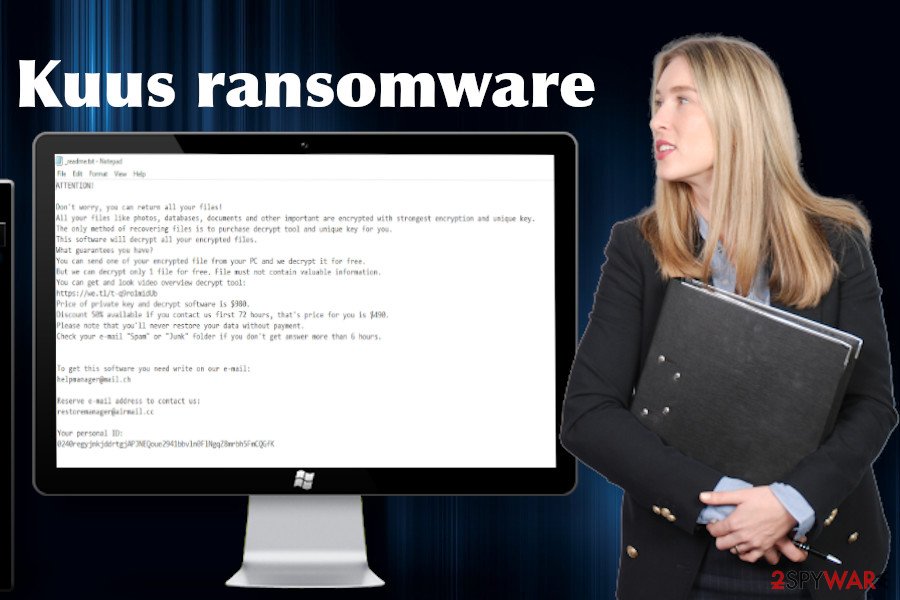
Kuus virus infiltrates machines via software cracks and disrupt the system to ensure persistence

Kuus virus infiltrates machines via software cracks and disrupt the system to ensure persistence
Kuus file virus can lock files on the connected external drives
The Kuus virus shows a tendency to widespread. Right after its detection, victims of this Djvu successor started reporting that the virus managed to lock files on the external drive. Although this fact is currently under investigation by experts, it’s most likely that the external drive has been connected to the targeted machine.
The .kuus file recovery on the external drive is the same as on the PC or laptop. If you have a functional decryption key, all files can be decrypted. Otherwise, you can only test the alternative data recovery methods, which may help to return at least some of the locked documents.
STOP ransomware variants most successfully spread through software cracks
Ransomware virus is the prevailing virus type circulating on the Internet for the last couple of years. Hackers take advantage of inexperienced PC users who fall for various social engineering tricks and unconsciously download file-locking viruses. Unfortunately, the minority of PC users take care of the backups, so ending up with ransomware often pushes them to pay the demanded ransom.
The vast majority of ransomware attacks are initiated via cracked products, such as key generators that are available on torrenting websites, such as The Pirate Bay. Therefore, to protect yourself from virus attacks, do not visit such websites, and stop pirating in any form. Keep in mind that pirated software is the best target for hackers. In addition to cracks and other pirated content, experts from Dieviren.de[3] warn that criminals can spread ransomware via:
- Email spam attachments. Malicious executables are typically disguised under EXE, Word, PDF, and similar attachments.
- Malvertising. Malicious ads positioned on script-infected websites can run a payload dropper once clicked.
- Fake software updates. People are more and more educated in the technology field, so this method is losing success. Nevertheless, some users still fall for clicking on fake updates saying that some Windows software is out-of-date, Java Flash player or web browser needs updates. Such pop-ups occurring on random websites are fake and should never be trusted. Software updates can be downloaded from official sources only.
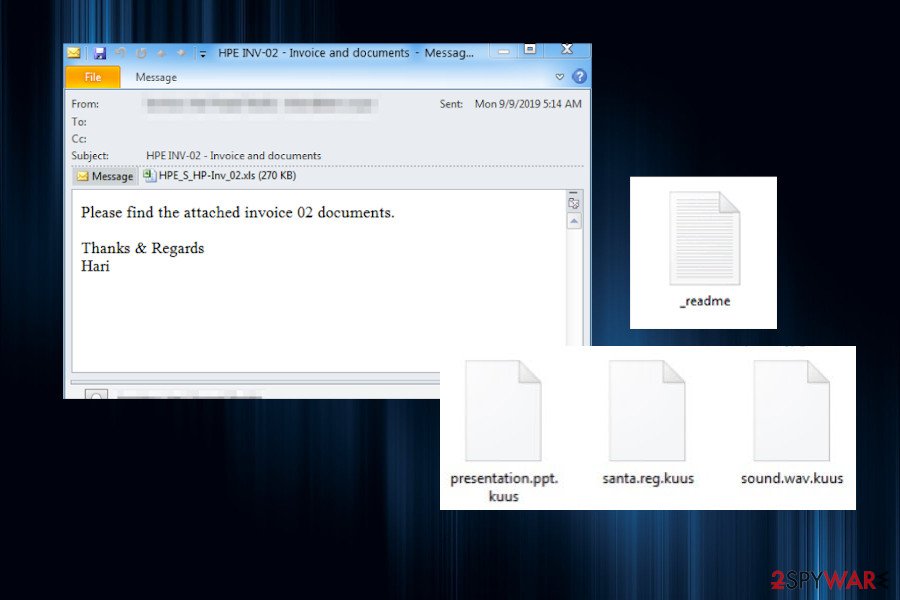
The victim understands that the machine has been infected upon finding inaccessible .kuus files

The victim understands that the machine has been infected upon finding inaccessible .kuus files
Eliminating Kuus ransomware and recovering the locked files
If you have become a target for hackers, the first thing that you have to do is to remove Kuus virus completely. This ransomware is dangerous due to a couple of reasons. First of all, it can permanently delete personal files. Second of all, it can run a secondary payload and download other cyber infections, such as Trojan or spyware. Thus, immediate removal is required.
To speed up Kuus removal, restart your machine into Safe Mode and launch a full system scan with a professional anti-virus program. Although you may detect some of the malicious virus files on the system, you are not very likely to be allowed to disable them. Thus, an automatic removal procedure is required with tools like SpyHunter 5Combo Cleaner or Malwarebytes.
When you successfully remove Kuus virus from Windows, you should check the machine for the damage. For this purpose, try using Reimage Reimage Cleaner Intego tool. In case it does not find any affected areas, you can proceed with the data recovery steps listed below.
Remove Kuus using Safe Mode with Networking
Do not fall for panic if you cannot run the AV scanner. Kuus virus may be running several processes to block security programs. To enable the software, restart the system into Safe Mode with Networking.
- Windows 7 / Vista / XP
- Click Start → Shutdown → Restart → OK.
- When your computer becomes active, start pressing F8 multiple times until you see the Advanced Boot Options window.
- Select Safe Mode with Networking from the list
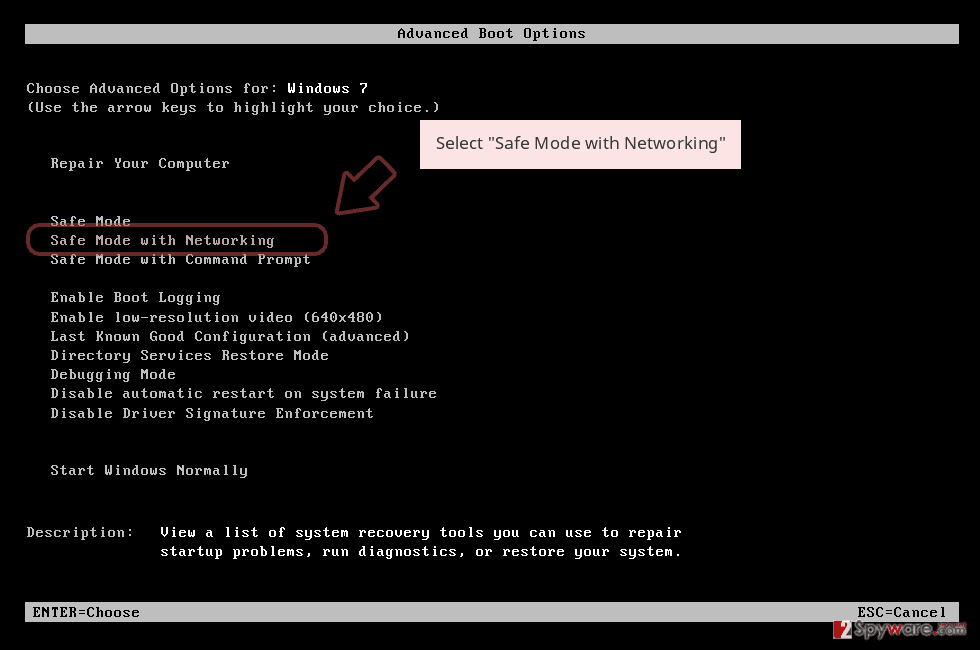
Windows 10 / Windows 8
- Press the Power button at the Windows login screen. Now press and hold Shift, which is on your keyboard, and click Restart..
- Now select Troubleshoot → Advanced options → Startup Settings and finally press Restart.
- Once your computer becomes active, select Enable Safe Mode with Networking in Startup Settings window.
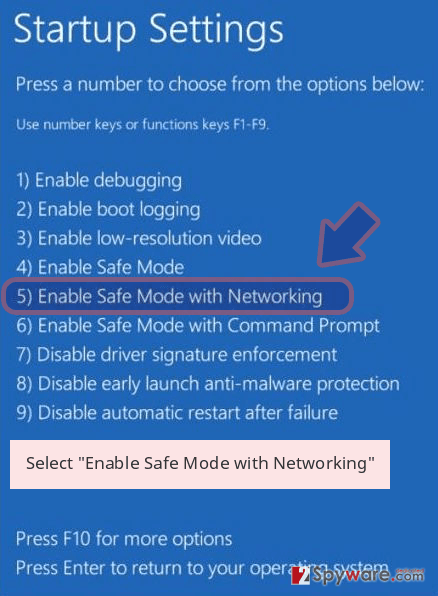
-
Log in to your infected account and start the browser. Download Reimage Reimage Cleaner Intego or other legitimate anti-spyware program. Update it before a full system scan and remove malicious files that belong to your ransomware and complete Kuus removal.
If your ransomware is blocking Safe Mode with Networking, try further method.
Remove Kuus using System Restore
Previous Windows version might help when trying to deal with ransomware.
Bonus: Recover your data
Guide which is presented above is supposed to help you remove Kuus from your computer. To recover your encrypted files, we recommend using a detailed guide prepared by 2-spyware.com security experts.
As we have already explained, Kuus ransomware virus belongs to the next-gen Djvu versions, which uses unique online keys. Thus, the official decryptor is not available, at least not yet. Nevertheless, we do not recommend paying ransom for criminals. Instead of that, try third-party data recovery methods listed below.
If your files are encrypted by Kuus, you can use several methods to restore them:
Install and run a scan with Data Recovery Pro
Data Recovery Pro might help to retrieve some of the .kuus files.
- Download Data Recovery Pro;
- Follow the steps of Data Recovery Setup and install the program on your computer;
- Launch it and scan your computer for files encrypted by Kuus ransomware;
- Restore them.
Use Windows Previous Versions feature for data restore
In case third-party software did not help you to retrieve personal files, try to regain access to them using the System Restore feature. (The feature must have been enabled before the attack).
- Find an encrypted file you need to restore and right-click on it;
- Select “Properties” and go to “Previous versions” tab;
- Here, check each of available copies of the file in “Folder versions”. You should select the version you want to recover and click “Restore”.
Use Shadow Explorer
Shadow Explorer is not likely to help in this case. The ransomware is set to run the command to delete Shadow Volume Copies. However, you can give this method a try in case the ransomware failed to run the command via the PowerShell successfully.
- Download Shadow Explorer (http://shadowexplorer.com/);
- Follow a Shadow Explorer Setup Wizard and install this application on your computer;
- Launch the program and go through the drop down menu on the top left corner to select the disk of your encrypted data. Check what folders are there;
- Right-click on the folder you want to restore and select “Export”. You can also select where you want it to be stored.
No official decryptor available.
Finally, you should always think about the protection of crypto-ransomwares. In order to protect your computer from Kuus and other ransomwares, use a reputable anti-spyware, such as Reimage Reimage Cleaner Intego, SpyHunter 5Combo Cleaner or Malwarebytes
When you work on the domain, site, blog, or different project that requires constant management, content creation, or coding, you may need to connect to the server and content management service more often. It is a hassle when your website is protected from suspicious connections and unauthorized IP addresses.
The best solution for creating a tighter network could be a dedicated/fixed IP address. If you make your IP address static and set to your device, you can connect to the CMS from any location and do not create any additional issues for server or network manager that need to monitor connections and activities. This is how you bypass some of the authentications factors and can remotely use your banking accounts without triggering suspicious with each login.
VPN software providers like Private Internet Access can help you with such settings and offer the option to control the online reputation and manage projects easily from any part of the world. It is better to clock the access to your website from different IP addresses. So you can keep the project safe and secure when you have the dedicated IP address VPN and protected access to the content management system.
While much of the data can be accidentally deleted due to various circumstances, malware is also one of the main culprits that can cause loss of pictures, documents, videos, and other important files. Potentially unwanted programs may clear files that keep the application from running smoothly.
More serious malware infections lead to significant data loss when your documents, system files, or images get locked. Ransomware is the one that is focused on such functions, so your device gets useless without access to needed data. Even though there is little to no possibility to recover after file-locking threats, some applications have features for such recovery in the system.
In some cases, Data Recovery Pro can also help to recover at least some portion of your data after data-locking virus infection or general cyber infection.
This entry was posted on 2020-07-20 at 04:33 and is filed under Ransomware, Viruses.

